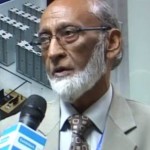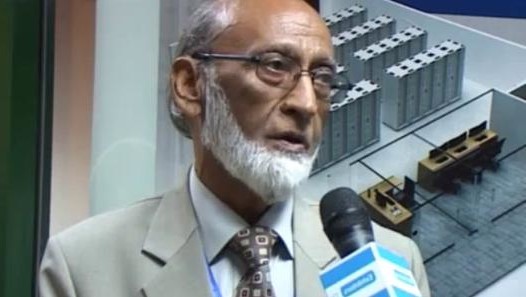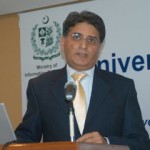ISLAMABAD ( ABRAR MUSTAFA )
Liked mind persoalities from telecom sector (including Mr Nooruddin Baqai, Prof. Dr. Ayub Alvi, Parvez iftikhar and a few others) are in final stages of setting up an ICT Think Tank in Islamabad. They have named it “ICT Forum Pakistan”. Fourm members studied and analysed the Information Memorandum which the Pakistan Telecom Authority (PTA) prepared for the upcoming spectrum auction of 3G and 4G Licenses. And from the platform of this Forum, They submitted a set of completely independent and unbiased comments/suggestions to PTA. Some of their suggestions have been accepted and may be included in Revised Memorandum.

Introduction:
On behalf of ICT Forum Pakistan, a newly established Forum (a think-tank on matters related to ICTs), we are pleased to offer our comments and suggestions to the Information Memorandum placed on PTA’s website, for the Next Generation Mobile Services Spectrum Award. Our comments are based on benchmarking and analysis carried out by individuals who have served Pakistan’s ICT sector at all levels
The suggestions are completely and absolutely unbiased, as we neither represent any segment, nor have any commercial or other interests of our own, purely formulated keeping in mind the interest of Pakistan and its ICT sector.
The comments and their corresponding suggestions are as follows:
1. Timeline:
The time available between the information session for prospective bidders (March 19, 2014) and the deadline to submit Application form and related-bid offers (March 25, 2014) appears to be short. This is because all the potential bidders have their Principals abroad and they normally need multiple Board-level approvals. This requires time.
On the other hand, grant of Licenses within 30 days of receipt of 50% advance payment is difficult to understand. Surely this can be done much quicker by PTA.
Suggestion: The prospective bidders should be given at least 4 (four) weeks to finalize their sealed-bid offers, ie the date of March 25 (and the subsequent dates) should be shifted by at least 3 weeks (to give them a total of 4 weeks here).
At the same time the maximum time lapse from receipt of advance payment to grant of Licenses should be capped at 5 working days.
2. Coverage Obligations:
Although we have heard some hype against the given roll-out obligations, we feel that 2100 MHz (3G) roll-out (coverage) obligations are challenging (especially because of security situation in the country) but not too stringent.
However the 1800 (4G/LTE) roll-out obligations seem to be tough. LTE is a data-only technology (although Voice Over LTE is fast coming), therefore in remote/rural areas there may not be a great demand for LTE for another few years. However if the demand is there, the competition will force the licensees to expedite deployment anyway. As given in the IM, the 4G operator would also be holding the 3G license, therefore in the initial years, he should concentrate more on increasing the penetration of 3G.
It is in the cities that LTE is going to thrive, where its main application will be for broadband access (with the help of 4G dongles with Laptops and Desktops). In countries like ours, who lack the extensive copper-cable/fiber infrastructure in the cities, LTE quickly fills that Access gap. Even in several advanced countries, LTE is used more for wireless broadband access than handsets etc.
Suggestion: 1800 MHz (4G/LTE) roll-out obligations may be relaxed. An example is presented in Annex.
3. Limitations on use – technology neutrality:
It can be expected that there will not be very strong enough competition in the auction of 1800 MHz segment, particularly when the bidder must purchase 2100 MHz slot first. On the other hand we opine that making it even partly technology neutral (ie allowing the spectrum to be used for 2G as well), will make the operators come scrambling for it!
In addition, once the roll-out obligations of 4G/LTE are relaxed (which is important, as explained above) a substantial part of extremely valuable 1800 MHz spectrum will remain unused during the initial months/years. In the interest of sector growth this is something that Pakistan cannot afford.
Suggestion: Initially, during the time allowed for 4G coverage, winners of 1800 MHz spectrum may be given a moratorium for that limited period, to use a part of the 1800 MHz band for any technology that they choose (eg: 2G)..
4. 850 MHz (old Instaphone) Spectrum:
This particular part oddly sticks out in the whole scheme, particularly because this part of spectrum has been restricted for only a new entrant. Through our own contacts we have tried to determine the possibility of a new entrant for this spectrum and our finding is that a serious new buyer is not expected to come. Therefore there is a risk that this valuable piece of spectrum may remain unsold and thus unused for another few years (till the next auction). This is yet another luxury that Pakistan can ill-afford
Suggestion: Through the IM a commitment should be given that this particular piece of spectrum, in the 850 MHz band, could also be purchased by the existing Licensees, provided there is no new bidder for it. Therefore at the stage of initial sealed bids, all bidders may bid for it. In case there is a new bidder, the bids of the existing licensees may be returned unopened.
5. Quality of Service/KPI’s:
A minimum user data-rate of 512 Kbps in case of 2100 MHz (3G) and 2 Mbps in case of 1800 MHz (4G) seem to be reasonable parameters (although here too one has heard noises against these).
6. Fees:
a) It is understandable that the auction scheme tries to encourage those successful bidders who opt to pay 100% upfront. But for the others an interest payment of Libor + 3% appears to be high. If there is some rationale, it is not given.
b) Similarly a rationale for the condition of payment in US Dollars is difficult to understand. As per information available with us, foreign owners of existing operators are unwilling to make capital injections from abroadthat lead to capital restructuring. The requirement of US dollars also discourages any domestic investors from investing.
c) Another payment (although not new), which does not appear to be based on any logic, is the Annual Spectrum Administration Fee (ASAF) of FAB, where Licensees are supposed to cover 75% of FAB’s total “budgeted expenditure”. It gives FAB total freedom to budget whatever it likes. In fact it works as a disincentive for FAB to control any waste in their expenditures.
d) And lastly the most surprising requirement is that of Bank Guarantees, which the operators are supposed to deposit in advance of all their scheduled payments. The cellular operators have investments of billions of Rupees, and have good track record of payments. They deserve to be trusted with their scheduled payments.
Suggestions:
a) For those who opt to pay in installments, interest rate should be reduced to nominally above Libor (perhaps to Libor + 0.5%).
b) As for the currency of the bid, the bidders should have the option of paying in Pak. Rupees – at least 50% ( if not fully).
c) ASAF should be eliminated, or rationalized at a lower level by fixing it (rather than linking to FAB’s budget).
d) Requirement of Bank Guarantees should also be abolished.
7. Base Prices:
We do not have any comment on the base prices, as these seem to be well-balanced. It would have helped infuse more confidence among the prospective investors, and also made it more transparent, if some rationale of each base price was also given.
8. Electronic Auction:
PTA has done well to go for electronic auction rather than the outdated outcry method. However it makes the process very sensitive Even a small leak can ruin the much delayed auction.
Suggestion: Special care must be taken to ensure that all necessary security procedures and firewalls are in place and being kept under constant surveillance.
9. Future Road-map:
The investors always consider Government’s Policies & future Spectrum Roadmaps while calculating and making their investment decisions. For example if another auction is planned by the Government in a year’s time, some investor/s may decide to wait. Conversely if it is known that the next spectrum release would be in some years, it may be a do-or-die situation for an operator at this point in time. In the present unclear scenario, in which the new Policy is under preparation and a Spectrum Roadmap is missing, the investors are compelled to take the worst-case scenarios in their calculations.
Suggestion: Government should commit in the IM a date for at least the next spectrum auction (eg: April 2017). It is also important to commit important outlines of the under-preparation Policy and that next spectrum auction commitment will not change..
10. Auction of Spectrum or License:
The existing Licensees have Technology Neutral Licenses and it was a commitment given to them at the time of award of existing Licenses that for the future they will only have to acquire fresh spectrum. Therefore it is unfair to ask them at this stage to acquire new licenses. We can understand that there may be several new conditions now, but for those some other innovative mechanisms, based on proper rationale, have to be found – like making some of those conditions part of “Spectrum License”.
Suggestion: Existing License holders should not have to acquire any fresh licenses. In fact they should be given assurance of renewal of their Licenses up to the end of 15 years from grant of spectrum at this point in time.
11. USF and ICT R&D Funds
It would help in attracting investors if Government could give firm commitments regarding its development plans using Universal Service and ICT R&D Funds, during the next 3 to 5 years.
For instance, a committed rapid increase in rural optic-fiber penetration would give the investors the confidence that while meeting coverage obligations, they would not have to make huge investments in the backhaul.
Similarly use of USF and ICT R&DF for the purpose of pushing wireless broadband in rural areas – both from the demand as well as the supply sides – will give needed impetus to growth and in furtherance of comfort to the investors regarding recovery of their investments.
12. Taxation:
Though it is not an IM issue, it is one item which can play a big role in ensuring success of the spectrum auction. Our study and analysis shows that if the Government moves to address this long-standing demand of the telecom industry and announces a tax reduction during the next two weeks. It will have a very positive impact on the investment decisions and therefore on the bid offer itself.
13. Miscellaneous:
We feel that there are some relatively minor items in the IM that should be improved/modified.
(a) The statement in the IM is absolutely untrue that: “Most of the tehsil headquarters of the country are not connected with Optical Fiber”. On the contrary, almost 90% of tehsil headquarters are connected with Optical Fibers. We feel that this piece of information is extremely important since the final roll-out obligations are based on coverage of tehsil headquarters.
(b) It is also not quite true to say that the telecom sector in Pakistan has “grown rapidly” in the last 10 years. Or that the “telecommunication sector in Pakistan has shown significant growth in recent years”. Such contrary-to-the-facts statements, dent the credibility of the IM.
(c) It is correctly stated that, compared with several similar countries, the Pakistan telecom regulatory framework provides conducive environment. Mention of awards received by Pakistan from independent international organizations, like ITU, GSMA, etc., may be made to underscore this point.
(d) We opine that it is important to stress in the IM that almost 50% of the population in Pakistan is less than 18 years old[1] (the segment of population who are the largest users of Broadband in the world). The Government has a separate Policy of promoting businesses by the youth, something that works for demand generation.
(e) Foreign remittances of year 2012-2013 as given as US$ 14 Billion (meaning: US$ 1.17 Billion per month). But it may also be added that during the first 6 months of the on-going fiscal year, the remittances jumped to US$ 1.3 Billion per month, and this has been a consistent trend over the last decade.
Conclusion:
As stated in the beginning these comments and suggestions have been formulated and submitted solely keeping in mind the national interest, as the authors have no self-interest in the whole process, nor are we watching someone else’s interest.
We therefore hope that our unbiased suggestions would be given due consideration.
Annex
One possible scenario of relaxed 1800 MHz (4G/LTE) coverage obligations:
|
Phase |
Time from the effective Date |
Coverage requirements |
|
|
Existing Cellular Mobile Operators |
Market Entrant |
||
|
First phase |
1 year |
1.5 years |
Coverage of cities of Islamabad, Karachi, Lahore, Peshawar and Quetta plus five (5) further cities |
|
Second phase |
2 year and 6 months |
3 years and 6 months |
Coverage of 50% of District headquarters |
|
Third phase |
4 years |
5 years |
Coverage of 100% of District headquarters |
|
Fourth phase |
6 years |
7 years |
Provide coverage of 90% of Tehsil headquarters |
Nooruddin Baqai Parvez Iftikhar
[email protected] [email protected]
+92 333 5189009 +92 333 5189009 +92 300 8555200
+92 333 5189009 +92 300 8555200 +92 300 8555200
+92 300 8555200
Note:The Forum commits itself to help the process to success as national objective and would be available for any question/answer sessions or clarifications through presentation material with some advance notice.


